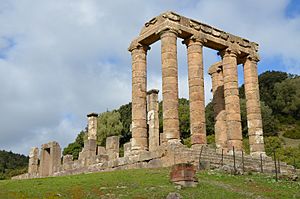Temple of Antas facts for kids

The Temple of Antas
|
|
| Lua error in Module:Location_map at line 420: attempt to index field 'wikibase' (a nil value). | |
| Alternative name | Tempio di Antas |
|---|---|
| Type | Monument |
| History | |
| Cultures | Punic civilization Roman civilization |
| Site notes | |
| Excavation dates | yes |
| Condition | ruined |
| Management | I Beni Culturali della Sardegna |
| Public access | yes |
| Website | Sassari, Fluminimaggiore, tempio di Antas |
The Temple of Antas is an ancient temple found in Sardinia, Italy. It was built by two different ancient groups: the Carthaginians and later the Romans. This area was important because it had valuable silver and lead.
The temple you see today is mostly Roman. But underneath its steps, you can find parts of an older Carthaginian temple. This older temple was built for a god called Sid Addir. Sid Addir was a later version of a very old local god named Sardus Pater Babai. He was the main male god for the Nuragic civilization, who lived in Sardinia long ago.
History of the Temple
The first temple was built around 500 BC. It stood on a special sacred rock made of limestone. Around 300 BC, it was repaired. The Roman temple was built much later by Emperor Augustus (who ruled from 27 BC to 14 AD). It was fixed up again when Caracalla was emperor (213-217 AD). If people were still using the temple in the 4th and 5th centuries, it would have been closed. This happened during a time when the Roman Empire stopped people from worshipping old gods.
The temple's remains were found in 1836 by a general named Alberto La Marmora. It was then rebuilt to look like it does today in 1967.
What the Temple Looks Like
The front part of the temple has six tall columns. These columns are about 8 meters (26 feet) high. They have special tops called Ionic capitals, which are shaped like scrolls. There used to be a triangular top part, called a pediment, above the columns.
You could enter the main room, called the cella, through two openings on the sides. The floor of the cella was covered with beautiful mosaics. Some parts of this mosaic floor are still there today. The temple also had two square pools. These pools held water used for special cleaning rituals.
It is thought that a large statue of the god Sardus Pater was inside the cella. Only a finger from this statue has been found. From its size, experts believe the whole statue was about 3 meters (10 feet) tall!
Other Discoveries at the Site
The area around the temple is also very interesting. It includes:
- A small necropolis, which is an ancient burial ground.
- Parts of an old Nuragic village. This village dates back to between the 13th and 10th centuries BC.
- Roman quarries where they dug out limestone.
- An old path that led from the temple to a sacred cave. In this cave, people practiced rituals involving water.
See also
 In Spanish: Templo de Antas para niños
In Spanish: Templo de Antas para niños
- List of Ancient Roman temples

